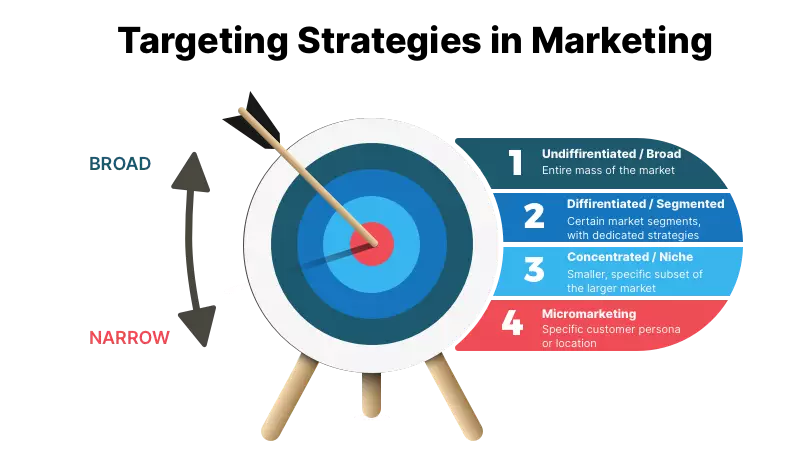If you’re marketing to everyone, you’re selling to nobody.
Such a deep quote, I know, my genius is almost frightening sometimes. But seriously, if you’re building a business, you have to get one thing right early on:
Who exactly are you selling to — and how do you reach them?
That’s where targeting in marketing comes in.
If you don’t get granular on the EXACT person you’re trying to help… you’ll be shouting into the void, and you’ll burn through all of your hard-earned dollars.
Sadly, I can’t give you a one-size-fits-all approach for targeting.
Startups, solo founders, and growing teams often need to switch strategies as they scale — and that’s completely normal.
But I’ll do my best to break down what targeting in marketing really means, unpack the four main targeting strategies, and show you when to use each one depending on your stage of growth.

Before getting into the targeting strategies, you REALLY need to know your customers.
Get granular here. Don’t limit yourself and list as many things as you can think of.
We’ll be ‘segmenting’ people based on these 4 dimensions:
The basics: age, gender, job, income, education. Sometimes it matters, sometimes it doesn’t. For example, I don’t market differently to men and women. It just doesn’t move the needle for me.
But if you’re selling luxury retirement plans or new-grad job coaching, demographics are suddenly important, right?
You know what?
At first, I thought this didn’t matter that much.
But where your audience lives matters MORE than most founders think.
It’s not just “US vs. UK” or “urban vs. rural.” Geographic targeting can get seriously specific — and it should, especially early on.
I’m telling you, understanding this WILL move the needle.
It’s also the dimension that requires the most brain power. But you got it.
What do they value? What frustrates them? What do they dream about? What TikTok rabbit holes are they obsessed with?
If I told you:
“Look, you’re an expert in your field, and you KNOW you could help a lot of people with your product/service. You’re just missing clarity. If you had a proven process that you can trust, you’d be able to put in a lot of action, and you’d make great progress.”
If I can make you feel understood, you’ll probably be way more open to hearing my solution.
And I actually DO have a (free!) solution for you. It’s my Startup Launch Roadmap.
It’s an e-book designed to help you build your product, launch it, and scale it to the moon.
By the end, you’ll have a solid plan to build and launch way faster… which also helps you attract investors (more on that inside).
This stuff is PO-WER-FUL. It shows intent, and these will be the easiest conversions of your life.
Did they click an ad? Visit a product page twice? Watch 80% of a video? When you understand the customer journey, you can do things like:

This is the moment I finally show you the 4 targeting strategies. You won’t use all of them, but you need to know the pros and cons of every single one.
By the end of this section, you’ll have a much clearer picture of who you should target.
This is the “spray and pray” approach. Brands that sell products that the whole world needs use this:
Think toothpaste, gasoline, soap. Everyone uses it.
There’s no segmentation, just one message for all. If you’re presenting to the whole world, it doesn’t make much sense to try to ‘segment’ the market.
Should you use it as a startup?
Hello no. Hard pass. Unless you’re literally selling bottled water, this will burn your budget and get zero traction.
“B-b-but the world needs to see my product!”
A random grandma doesn’t need your B2B agentic SaaS, okay?
Only a very specific group needs it.
This one is REALLY important.
This is where most early-stage founders should start. You pick a tight niche and go hard.
Instead of “people who want clothes,” it’s “women who only wear sustainable athleticwear.”
Or “golden retriever owners who only buy organic food.”
Here’s why this works:
Finding a niche isn’t easy, and once again, it requires you to spend some time thinking.
While this strategy has ‘limited growth opportunities’ in theory, for a small creator, ‘limited’ is the key to getting started. It’s the only way to avoid the feeling that Google hates small creators and allows you to compete with giants.
When you look for a niche, find one with enough people who have the buying power to afford your product. That’s product-market fit right there.
Also, can you find a subniche?
For example, instead of focusing on “fitness”, you could target new moms who want to get back into fitness. The competition is EVEN smaller… and all the benefits above apply even more too.
This one’s great once you grow. You build different content for different groups, but all under the same brand.
Let’s say you sell eco-friendly T-shirts (hypothetically):
You make one message for people who care about organic materials.
Another for people who care about fair labor.
Another for people who want crazy-soft fabric.
This is all for the SAME shirt, but from different angles.
The downside is that it’s expensive. You’re basically running 3+ campaigns instead of one. Definitely only use this once you’ve already nailed your niche.
Oh la la…Now we’re getting fancy.
Micromarketing means ultra-specific targeting. s
Think: one street, one influencer’s audience, or one behavior (like clicking a certain button).
Look at some examples to bring it home:
This is NOT scalable at first. But damn, can it be lucrative.
For example, you would do this when running retargeting or loyalty campaigns. Or if you want to build more trust with your highest-value buyers.
The drawback is the impossibility of scaling it (until you have some systems in place).
This article is NOT a ‘theory’ article. If you don’t act on it, you might as well have scrolled.
Let’s recap the most important points, so you know what to do:

Email subscription is available ONLY TODAY (oh, okay, and tomorrow).
Surely, we respect your inbox! Unsubscription works every day.

We’d love to tailor your experience — which of these best describes you?